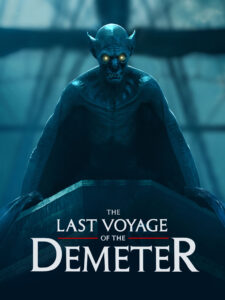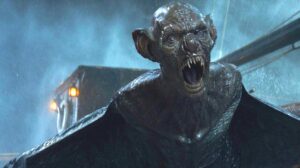 The source material for the 2023 horror film, The Last Voyage of the Demeter, is a chapter titled “The Captain’s Log” from Bram Stoker’s 1897 novel, Dracula. That should be enough to keep you from boarding the vessel. I mean, who would want Transylvania’s most famous vampire as a shipmate?
The source material for the 2023 horror film, The Last Voyage of the Demeter, is a chapter titled “The Captain’s Log” from Bram Stoker’s 1897 novel, Dracula. That should be enough to keep you from boarding the vessel. I mean, who would want Transylvania’s most famous vampire as a shipmate?
I could have presented this post as a Guilty Pleasure, given that The Last Voyage of the Demeter received so-so reviews and bombed hugely at the box office, canceling any thought of a sequel. But I had no problem with the film, and its two-hour run time seemed to fly by. (Remember, I’m easily entertained.)
LAST COMES FIRST
Even if you’ve never seen the classic 1931 version of Dracula with Bela Lugosi, or any of the numerous other versions, you’d have to know that Count Dracula, aka Nosferatu, had to somehow get from Transylvania, his home base, to London, where the blood bank was wide open. His mode of transportation? The merchant ship Demeter (pronounced De-ME-ter), where our vampire friend will take full advantage of the limited supply.

Clemens helps Anna, a blood donor he discovered in one of Dracula’s crates.
If the title doesn’t give away the storyline, the first few minutes of the film leave nothing to the imagination. The Demeter, with seemingly no one on board, washes ashore in England. Nothing but crates, which the Count had arranged to be unloaded and taken to Carfax Abbey in London, his new home base.
HOME BEFORE DARK
After the opening, the story takes us back a few weeks to the waterfront in Varna, Bulgaria, where some Romanian peasants are delivering Dracula’s crates to the Demeter. Captain Eliot is a bit reluctant to take on this cargo, but a lucrative up-front fee, plus the promise of bonuses for him and the entire crew upon delivery to England, changes his mind. Rather than help load the crates on board, the peasants—who know better—head for the hills, saying they need to be far from there before nightfall.

Nosferatu is rather frightening.
So off sails the happy ship, and things go well for a while. The story is told through a voiceover from the captain’s logbook, and also via its main character, a young doctor named Clemens. Dracula, in his creepy-looking Nosferatu guise, first appears on deck as the Demeter plies the waters of the Aegean Sea. His initial snacks are comprised of the animals that are kept on board. Not the rats…all of them had previously abandoned ship, which should have been a clue for the humans, ya think?
From there, it’s one crewman after another, Dracula’s bite turning them into vampires themselves, even the captain’s grandkid, a young boy. Some of them, later exposed to the sun, burst into flames (gross but cool scenes).
The Last Voyage of the Demeter offers an alternative ending to what Bram Stoker wrote in “The Captain’s Log.” In typical Hollywood fashion, it was primed for a sequel. But as I said, that won’t happen. Too bad. The film was far from the best horror movie I’ve ever seen, but also far from the worst. If you’re into vampires, or horror in general, it’s worth a look.

Hi Mike
I watched this movie last night because of your post. You’re right about it being better than the reviewers’ rating of 48%. I would agree with the audience score of 75% overall.
I like Liam Cunningham, who played the captain, and I liked the invented character, Clemens, the doctor. It’s most likely because I have an analytical mind (systems analyst/programmer here) so I appreciated where this character was coming from. His insistence on looking at the situation scientifically gave the story a more modern feel, especially given the race issues that character also faced.
That said, I don’t watch many horror films because my analytical mind can’t leave the inevitable plot holes alone. No matter the movie, the script always has someone going into the basement alone and in the dark long after events should have convinced them not to do it. In this case, it was also hard to believe they could never find where Dracula was hiding on such a small ship, even after they finally (too late) decided to look in the crates.
However, I did like the ending where they were clearly setting it up for a sequel. Even if they don’t do one, most of the horror films I’ve watched allow the characters to think the villain has been vanquished only to show the audience (at least) they were wrong. Or, as in this movie and in one of my guilty pleasures, “Pride and Prejudice and Zombies,” they show everyone how mistaken they were about the true scope of the horror they face… right before they leave the audience wondering what happens next.
Since you’re a writer and this blog is often about the craft, I will mention a pet peeve of mine. While many people say they enjoy call-outs to other movies, TV shows, or books, I absolutely hate them because they pull me out of the current story. In this case, they named the doctor Clemens and then called the ship’s dog Huckleberry. I might have been able to let it slide if the captain’s grandson hadn’t made a point of introducing the dog to Clemens by saying its name was Huckleberry, but he always called him Huck.
Once that burr was under my blanket, it was there to stay. What’s your opinion of bringing the names of other characters, people, places, events, etc. into your story in sometimes less subtle ways than this?
Clemens? Huck? It didn’t even register in my brain, which of course is dealing with other issues at the moment. I try not to over-analyze any movie that I watch, just take them at face value. For example, I just watched Leviathan (1989), a box office bomb with terrible reviews. Got a kick out of it.
It’s been a long time since I’ve seen “Leviathan.” As I recall, the main reason I watched it back in the day was that I was a big Peter Weller fan.
As far as noticing the details, it’s the curse I still bear from being a software developer for a complex accounting program. When the tiniest change in once section of the code could have major conflicts somewhere else, I had to notice everything and keep all of the little details in mind.
On the other hand, it helps with keeping plot threads straight, so there is an up side. And of course, I’m not as distracted as you are. My thoughts and prayers are with you.
Thanks, Kate.